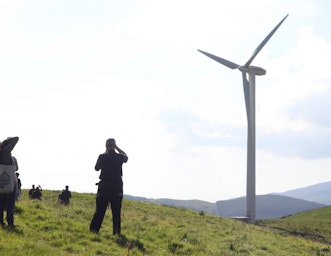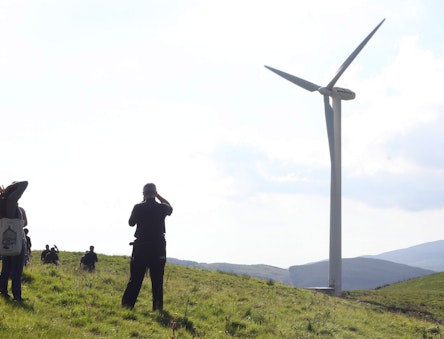
Heat Pumps
Heat pumps are the best current option for reducing the carbon emissions from home heating in most UK homes. This is because a heat pump is powered by electricity that we can supply using renewable energy sources. Through the UK winter, a heat pump can use electricity from wind farms, hydro turbines, and wave & tidal power.
For most houses in the UK, proper heat pump sizing and design will keep you comfortable in the wintriest conditions. This means getting a proper room-by-room heat loss assessment, in order to size and specify radiators that will run on low flow temperatures and still keep your home cosy.
A heat pump should use one unit of electricity to deliver three or four units of heat. That means running costs should be competitive with gas, and much lower than direct electric heating. Read on, including the related questions below, to find out how to ensure a heat pump will work for you.
Is a heat pump a low carbon choice?
Carbon emissions from using a heat pump are already about 80% less than those from a gas boiler. That’s because average carbon emissions from the UK electricity grid are about two-thirds as much per unit of energy as those from burning gas. A heat pump then uses one unit of energy to make three or four units of heat. There will be a bigger carbon saving against fuels like oil or LPG.
Even on a green electricity tariff, it’s important to use less energy in order to keep nationwide electricity demand low. Using less energy makes it quicker and easier to get to a zero carbon grid. Insulating your home as much as possible is therefore desirable even if a heat pump could heat the house without it. If you have the resources, aim for a home refrofit to a level much better than UK Building Regulations.
What is a heat pump?
You’ll almost certainly have a heat pump in your home already, because small heat pumps power fridges & freezers. The process is complex, but basically the heat pump is absorbing heat from one place and moving it to another place. Most air conditioning units are heat pumps, as are efficient types of tumble-dryer.
Heat pumps for central heating extract energy from the outside air or from under the ground. These are low temperatures (below 10°C in winter) but there’s still lots of energy available compared to absolute zero, which is -273°C. Therefore heat pumps will still heat your house in very cold weather.
A ‘coefficient of performance’ (COP) measures the efficiency of a heat pump. A COP of 3 means a heat pump gives 3 units of heat energy for each unit of electricity used. For overall performance, check for a comparison of total heat output to total electricity use across a year, under different weather conditions. This may be given as a seasonal COP (SCOP) or a seasonal performance factor (SPF).
Is my heating system suitable for a heat pump?
To work well, a heat pump must be delivering low temperature heat. Ideally that means sizing the system to supply flow temperatures of only 40 to 45 degrees to radiators when it is -3 degrees outside. And also using weather compensation controls to modulate the flow temperature to radiators according to the outdoor temperature. Getting a proper room by room assessment of heat loss is important for choosing suitable radiators.
For some homes, existing radiators will be large enough – especially if the house has been insulated since the radiators were put in. For others, replacement or additional radiators may be needed to give sufficient surface area. Where wall space is limited, smaller fan assisted radiators can work on low flow temperatures. Another good option is underfloor heating, with a flow temperature of 35°C to 40°C. It’s important to avoid pairing a heat pump with small radiators that need high flow temperatures, of say 60°C, to keep the house warm. That would result in poor efficiency and high running costs.
You’ll don’t necessarily need high levels of insulation for these low flow temperatures to work, but it will make it easier. Some old houses that are difficult to insulate well have made good use of a heat pump. It can help if they have a reasonable amount of ‘thermal mass’ – such as thick solid stone. Thick walls retain the heat from a low temperature system better than a lightweight home.
What about domestic hot water?
With a heat pump you’ll need a store or cylinder to hold the hot water for bathroom & kitchen use. This should be heated up to 60°C perhaps once a week to kill off possible legionella. The rest of the time the temperature can be lower (but still warm enough for washing), which will make the heat pump run more efficiently. Using a heat pump to do a 60°C top-up when necessary is much more efficient than using an electric immersion heater.
In general, a hot water cylinder means a bit more risk of heat loss. For example from long pipe runs, or just from always heating more water than you need. Sizing the store correctly and minimising hot pipe runs will keep a system efficient. It’s also important to minimise hot water use by putting in an efficient shower head and spray taps.
For more than half of the year you could get enough hot water from solar water heating. Or if you have solar PV panels you could divert excess PV output to the cylinder, or set the heat pump hot water cycle for a time of day when the PV is likely to be generating the power needed.
Ground source, air source or water source?
A heat pump becomes more efficient as you reduce the temperature gap between the heat source and the heat demand.
A ground source heat pump (GSHP) should therefore be more efficient than air source. This is because about two metres down the ground stays around 10°C all year, protected from temperature extremes. This heat is almost all solar energy, absorbed by the ground during summer. It does cost much more to put in ground loop, but it may be worthwhile in places that get extremely low winter temperatures, such as northern Scotland or homes at altitude.
Air source heat pumps (ASHP) still work very well even as air temperatures drop below zero. Their electricity use will increase a bit when outside temperatures get really cold, and if the collector needs defrosting this uses more energy. However, lots of people have air source heat pumps that give a great ratio of electricity to heat as the temperature dips well into minus figures. The higher running cost compared to a GSHP could well be offset by a much lower upfront cost.
Some air source heat pumps are air-to-air rather than air-to-water. Warm air heating is uncommon in the UK, and this may only be an option if you’re building or renovating to a very high standard.
Water-source heat pump systems can be very efficient. However, they’re not as common because you’ll need a water source that won’t freeze – such as a spring or borehole.
How much will a heat pump cost to run?
With good design and the right choice of electricity tariff the running costs of a heat pump can be much lower than those of a gas boiler. Even when compromises have to be made on efficiency, it should be possible to get running costs about the same as gas. As mentioned above, this will make it far cheaper to run than direct electric heating, and probably also cheaper than oil or LPG.
The July 2024 price cap equates to almost 5.5p per kWh for gas and almost 22.5p per kWh for electricity. If heating oil was to cost about 55p per litre that would give a running cost similar to gas, because oil contains about 10kWh of energy per litre.
Based on those prices, a modern gas or oil boiler running at about 85% efficiency would give an actual heating cost of about 6.5p per kWh. In comparison, a heat pump with an SPF of 3.5 would also cost about 6.5p per kWh of delivered heat.
With either a better SPF or a tariff that gives a lower average unit price the heat pump would get cheaper. For example, if an SPF of 4 can be achieved, that would mean a running cost of about 5.5p per kWh of heat. Or with an SPF of 3.5 and a variable tariff that gives an average rate of about 20p per kWh, running costs could be about 5.7p per kWh.
To reduce heating costs more substantially it’s still important to refurbish our homes with better insulation and other energy saving measures, whatever heating we then use. A combination of decent measures could cut annual heat demand for an average home from about 10,000kWh to less than half of that.
How much will it cost to install a heat pump?
At the moment installation prices can vary a lot. The best thing to do is to compare quotes from a few installers. The kilowatt rating of the heat pump should be a guide to expected costs. A good home retrofit to improve insulation will allow you to install a smaller (and much cheaper) heat pump.
One important factor is that oversizing heating systems is common, for both boilers and heat pumps. A proper room-by-room heat loss calculation is important for correct sizing. A heat pump of less than 10kW heat output should be fine for most homes. About 5kW heat output should be enough for smaller or well insulated homes. Proper sizing can greatly reduce the upfront cost, which is related to the kilowatt rating of the heat pump.
Recent figures collected for systems installed under the UK government’s last incentive scheme suggested that domestic air source heat pumps cost about £1,000 per kilowatt (kW). About half of these were rated at between 6 and 10 kW, putting the cost between £6,000 and £10,000. A further quarter of installations were rated at 11 to 15 kW, so would have cost a few thousand more. It’s important to be clear that these are average figures, and quotes for more carefully sized systems could be lower.
For ground source heat pumps, the cost under the scheme was about £1,500 to £1,800 per kilowatt. When you compare ground loop options, trenches are likely to be cheaper than boreholes. These installations were also mainly between 6 and 15kW, putting costs in the range of £10,000 to £25,000.
What support is available?
In England and Wales the Boiler Upgrade Scheme grant has just increased to £7,500 for all heat pumps. To get the grant, a house needs an Energy Performance Certificate (EPC) issued within the last 10 years that does not include recommendations to add either loft or cavity wall insulation. If you need to check your home’s EPC, use the government’s online EPC register.
Your heat pump installer will claim the grant on completion of the job and you’ll pay them the remaining cost. Ofgem oversee the Boiler Upgrade Scheme and you can find accredited installers through the Microgeneration Certification Scheme (MCS).
In Scotland or Northern Ireland try either Home Energy Scotland or NI Energy Advice to see what support for heat pumps is available. For example, the Scottish Government has announced a grant of £7,500 to £9,000 for installing a heat pump.
Finding an installer
You can find all installers accredited for the current grant through the Microgeneration Certification Scheme (MCS).
For additional verification of installers you could look for those with ‘Verified’ or ‘Elite’ status on Heat Geek’s map of trained installers. Heat Geek also have a useful guide about what to consider when meeting installers and making a choice.
Another listing of heat pump professionals can be found at the Ground Source Heat Pump Association.
Further information
CAT runs the annual one day course Renewables for Households: heat pumps.
There are several useful videos about heat pump and heating system sizing on the Heat Geek website.
On Trystan Lea’s website he gives a detailed example of designing and running a heat pump efficiently in an older house. His website includes many pages with lots of data about how he evaluated heat loss, sized radiators, and so on.
Trystan Lea is one of the people at OpenEnergyMonitor, who supply monitoring equipment for heat pumps. This can help you understand how a heat pump is running, and improve efficiency and running costs. They have recently launched a site that reports on the perfomance of some actual heat pumps.
Ethical Consumer have assessed several brands that manufacture heat pumps, looking at their environmental and ethical record.
See also the related questions below for more details.
Related Questions
Are air source heat pumps noisy?There will be a little noise – but modern air source heat pumps do surprise many people with how quiet they are.
Bear in mind that performance has improved in recent years as the heat pump industry has developed. The external part of an air source heat pump (ASHP) is basically the same as an air conditioning unit, but they vary a lot – so don’t judge all ASHPs by the noisiest air conditioner.
Because noise perception is subjective, the best thing to do if concerned is to check how a real installation sounds to you. This could be a friend who has installed one, or by finding someone through a local energy or environmental group who has one. Or try Nesta’s “visit a heat pump” scheme.
Some heat pumps are certified under the Quiet Mark scheme.
Decibels are measured on a logarithmic scale, which means that an increase of 10dB will correspond roughly to a doubling of loudness. Measurements of environmental noise are usually made in ‘Acoustically Weighted Decibels’, or dB(A), which includes a correction for the sensitivity of the human ear.
To see how the decibel levels of different units compare, you can ask your installer and check technical literature on manufacturers’ websites. Check the noise rating at full power.
Ten years ago, about 65 decibels (db) may have been quoted for the noise level at 1 metre from a collector unit. New units may now be able to run at less than 50db. By comparison, normal conversation may be at a noise level of 50db, a busy office about 60db, and a busy street about 70db.
A buffer tank is basically a water store that ‘smooths’ the output of the heat pump to the space heating. This is separate to the need for a cylinder to store hot water for the bathroom (although they might be combined into one unit, with separate internal sections).
In many homes there’s no need for a buffer tank. The system design can use emitters that have a decent amount of mass, such as radiators with a high water volume or underfloor heating pipes in a thick screed. This can avoid the need for a buffer tank and make it easier to keep flow temperatures lower.
A buffer tank is more likely to be needed in a larger homes, if it is zoned for different levels of heating in different areas. Whereas for an average or smaller sized home or one that’s pretty open plan, it may not be required.
A buffer can help to manage the flow around a heating system with microbore pipework (rather than replacing the pipe). And it may also help with the defrost cycle for an air source heat pump, in a house where the emitters don’t have much mass.
In most cases, the best thing is to find a knowledgeable installer and go with the set-up that they recommend – whether with or without a buffer. They should be able to clarify to you if there is a need for a buffer tank, along the lines of the information above.
Trenches should be at least two metres deep to harness a consistent year-round heat source. They will need 50-80 metres of pipe per kilowatt (kW), or 10 metres of ‘slinky’ coiled pipe per kW, with at least 5 metre distance between trenches with coils. So a typical 8kW heat pump requires around 400m2 of ground area for slinky coils. Note, however, that this will depend on a number of factors, including ground conditions.
Boreholes need 20-50 metres of pipe per kW, and will usually be 100-150 metres deep. You may need 2-4 pipes per borehole, or more than one borehole. The Pipe diameter should be 20 to 40mm for best performance: large enough to reduce pumping power but small enough to increase flow velocity and cause ‘turbulent flow’ (giving better heat transfer).
Bear in mind that installers trying to reduce costs might skimp on the length or bore of pipe, or the depth of the trenches.
As the outside air temperature drops, the gap will increase between that outdoor temperature and the temperature needed in your home. The wider the gap, the more electricity the air source heat pump (ASHP) will use.
In very cold weather, frost may build up overnight on the external part of an air-source heat pump. Running a defrosting cycle will add a bit more electricity use to the normal consumption.
When comparing quotes for the SCOP or COP, check what temperature they’re based on, and if hot water is included. A heat pump will have different SCOPs quoted for different flow temperatures around the central heating. For example the SCOP might be 3.5 at 55°C but 4.5 at 35°C.
A COP (rather than SCOP) will be for a particular outdoor temperature. So for example it might be quoted for A5/W55, or for A-7/W35. The figure for A is the outdoor (ambient) temperature, and the figure for W is the flow temperature delivered from the heat pump.
If you live in a place where very cold winters are common, then you may want to look more carefully at how the heat pump will perform at very low temperatures. If you can design in low flow temperatures it could still perform well. Or the extra investment in a ground source system may be worthwhile, because you’ll always have a source temperature of about 7°C.
It sounds great in principle to heat your house using a heat pump, and get the electricity needed using solar photovoltaic (PV) panels.
However, the UK climate makes this impractical. Very little solar energy is available at the time of the year when your heat demand is greatest. A fairly large 4kW solar PV roof (around 30m2) will produce around 15kWh of electricity per day in May or June, but only 3 or 4 kWh on a typical day in December or January. A heat pump may need about twice as much electricity as this, plus you’ll have several other electricity demands to meet.
A solar PV array can still be a good investment in itself, generating low carbon electricity to use in the home or to export and contribute to decarbonising the grid.
If you live in a rural area, you might have wind or hydro power available to you, which give more energy in winter. However, most homes don’t have a suitable site for these energy sources.
In a zero carbon future we will be able to run heat pumps using electricity supplied through the grid from renewable energy sources that generate power in winter. These are mostly large-scale – such as offshore wind farms and wave & tidal power.
Signing up for a ‘green tariff’ from a company focused only on renewable energy is a great way to support the renewable energy industry. Changing your supplier is now very easy, and in most cases won’t make any difference to your supply.
One issue is that the small companies that specialise in renewable energy may not be part of the ‘Warm Home Discount’ scheme (although if they get enough customers they will be brought into it). This scheme gives a rebate to people at risk of fuel poverty, such as those receiving Pension Credit Guarantee Credit and some others. If this applies to you then you’ll need to stay with a larger provider to get this rebate.
Which green tariff?
We recommend choosing a company that only supports renewable energy. This means your money will not indirectly go to operate or build fossil-fuel power stations.
All electricity providers are required by the government to include some electricity from renewable sources. If they just offer a green tariff as one of a range of tariffs, then they may be simply charging a premium for electricity they’re legally required to produce! This is why we recommend companies that invest your electricity bill payments only in more renewable electricity.
If enough people sign up for renewable energy tariffs with these suppliers, then demand for renewable electricity will rise above the minimum government requirement. Therefore, as well as signing up yourself, encourage others to do the same.
The Ethical Consumer website gives a ranking based on the ethical and environmental record of electricity & gas suppliers. You have to be an Ethical Consumer subscriber to see the whole report, which gives more details.
I’m on a green tariff – so can I use as much electricity as I like?
It’s important to bear in mind that signing up to such a tariff does not mean you can leave all your lights on because it’s all zero carbon! If you use more electricity through your green tariff it means that less renewable electricity is left for those that are not on green tariffs. This means that more fossil fuel will be burned to meet their share of energy use.
Also, every means of generating electricity has some environmental impact, including the energy and materials that go into manufacture and installation. Energy saving measures are vital, because it’s them much easier to meet our electricity needs with energy sources such as wind farms, and wave & tidal power. Our Zero Carbon Britain project has a lot more details about how we can meet all our energy needs using only renewable energy.
Wet underfloor heating is definitely something to consider if you are replacing your heating system, undertaking renovation work, or building from scratch. It gives a very even temperature over the floor area, and works well with renewable energy sources and well-insulated buildings. Underfloor heating is slower to respond to changes or to heat up from cold, so is best suited to well-insulated buildings and works well if you have good levels of thermal mass.
The system should be sized to run with a flow temperature of 35°C, compared to radiators which may run at 60°C or more. To allow for a low flow temperature, the pipes should be spaced at 100mm or less. It’s therefore a good match for a ground or air source heat pump as these are more efficient when supplying low flow temperatures. Underfloor heating also works well with a modern condensing boiler, because this will then run in condensing more more often.
The radiant heat given off by the floor results in high comfort levels. In our experience this means that, in practice, you can run it at lower temperatures and save more energy. It should be possible to have the house at a temperature 2 or 3 degrees lower than with conventional radiator use. It’s great for rooms with high ceilings because the heat goes up the centre of the room. You’ll also have more free wall space without radiators.
There are several ways of installing underfloor heating – see below for examples based on what we’ve done at CAT. It’s possible to do it yourself but you’ll need good building and plumbing knowledge & skills. A professional installer can do a pressure test to check for any leaks and ensure it is stable before covering it over. 15mm bore pipe is better than 10mm, as it’s easier to then pump the water around. A manifold connects the pipes to the heating system and heating controls just as in a normal heating system.
Solid Floor
Start with a limecrete or concrete subfloor above a damp-proof membrane. Above this, add a layer of solid insulation (could be cork), which should also run up the edge of the floor to stop heat escaping into the walls. Then lay the underfloor heating pipes (cross linked polyethylene or barrier pipe), running back and forth along the length of the floor. Various fixing systems are available to hold pipes in place. Over this lay a screed of limecrete or concrete, covering the pipes by at least 50mm. Finally, add a floor finish such as tiles, slates or stone.
Suspended Floor
Insulate between (and perhaps also below) the joists to prevent heat loss, and then lay a subfloor over the joists. The underfloor heating pipes lie on top of this, between battens. To ensure that the heat is evenly distributed, you can either fill the gaps with a weak sand/lime mix, or fit aluminium plates to the pipes to dissipate the heat evenly through the floor. The floorboards then sit on top of this, held by the battens.
The timber must be really dry – if it isn’t, it may shrink and crack with the heat. The moisture content of timber for a wooden floor with underfloor heating should be about 8% for retrofitting and 10% for a new build. Alternatively, lay it loose for the first year, so that adjustments can be made for any movement. The surface temperature shouldn’t go above about 30° or the timber may distort, and you should leave a gap around the edge of the timber floor to allow for expansion.
Direct electric heating, such as electric wall heaters or an electric boiler, will not usually be a good choice for heating a house.
This is because direct electric options give only one unit of heat for each unit of electricity consumed, whereas a heat pump can give three or more units of heat for each unit of electricity it uses. Therefore the running costs of direct electric heating will be 3 or more times as much as a heat pump.
In addition, the widespread use of direct electric heating would put a very high load onto the electricity grid. This would make it much harder to build enough renewable energy generation to get to a zero carbon grid. Minimising electricity demand is therefore important, which is why heat pumps are a good option.
There’s currently a fair amount of promotion of ‘hydrogen-ready’ boilers, which seems to be led by the fossil fuel industry. Note that gas boilers have been required to be able to burn a blend with about 20% hydrogen since the 1990s. Therefore in almost all cases there’s no need to change a boiler to be ready for only a blend of hydrogen into the gas mains (if that were to happen in future).
In terms of moving to 100% hydrogen, there are some potential issues. Making hydrogen from electricity is even less efficient than direct electric heating (which is already a poor choice). One unit of electricity will give only 0.6 units of heat, based on hydrogen generation being 70% efficient and the boiler 90% efficient. Overall, a heat pump would then be 5 or 6 times as efficient as a hydrogen-burning boiler.
Also, the main industry proposal is to make hydrogen from fossil fuel (natural gas) and use some not yet proven way of capturing and storing the emitted carbon. There are big questions about how this will be achieved and how much the hydrogen will then cost.
Related events


Build a Small Wind Turbine
6th September 2025
Introduction to Renewables for Households
13th September 2025
Renewables for Households: Insulation
8th November 2025Study at CAT: Our Postgraduate Courses
Related news

More solar energy for CAT
4th April 2025
CAT Conversations – Dr Frances Hill
10th July 2024
CAT Stories – Aber Food Surplus
23rd May 2024
Taking back power
9th April 2024
Related Short Courses: Energy
30th June 2025 Short Course Join a CAT student teaching week and explore the energy requirements and carbon emissions of different international contexts and their potential to meet their energy needs more sustainably. Through a…
Read More6th September 2025 Short Course Generate electricity with a homemade wind turbine. Join Tom Dixon of V3 Power to build a wind turbine yourself, from scratch. Drawing on over ten years of experience in teaching…
Read More13th September 2025 Short Course Rethinking household energy provision – bringing energy into your own greener hands. Where our energy comes from has a big impact, and to reach a Zero Carbon Britain it needs…
Read More
Did you know we are a Charity?
If you have found our Free Information Service useful, why not read more about ways you can support CAT, or make a donation.
Email Sign Up
Keep up to date with all the latest activities, events and online resources by signing up to our emails and following us on social media. And if you'd like to get involved and support our work, we'd love to welcome you as a CAT member.



